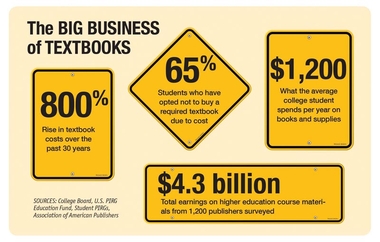Textbooks are worth their weight in gold

by William Schmick
The Independent Investor
Forget the stock market, internet, and whatever you might think is worth investing your money. The good old college textbook beats them all. That boring first-semester hardcover and similar books have risen over 1,000 percent in price since 1977.
Textbooks are big business — estimates for the total value of the textbook industry range from $7 to $9 billion.
And just a handful of companies sell them. The five largest publishers are Pearson Education, McGraw-Hill Education, Scholastic, Cengage Learning and Houghton Mifflin Harcourt. They have been around a long time, carry deep pockets and usually acquire any start-ups or smaller competitors in quick order.
Some analysts compare them to drug companies because they have similar economics.
In the pharmaceutical sales model, for example, drugs are marketed to the decision makers—doctors, hospital pharmacies and the like. The patient, at least those with health insurance, end up paying the price, but much of those costs are paid for by the insurance company or Medicare.
Medical decision makers’ criteria are usually not how cheap or expensive a drug might be; instead, they select those drugs that are the most efficacious with the least number of side effects for their patients.
In the textbook industry, teachers (mostly professors), are the decision makers at colleges, and like doctors, could care less about the costs of a textbook to the student. They demand the most up-to-date educational information possible since they strive for academic excellence in the classroom.
It doesn’t help that today the information advances occur at such a rapid pace that most books are out of date by the time they are printed and in the hands of students.
There is another wrinkle that boosts the price of textbooks. Today, one in four colleges bundle their textbooks with an access code, which expires at the end of each semester — all the materials that a given student needs to participate in the classroom in this access code paywall. Once you pay for the access code, you get your login ID. In return, the student gains access to workbooks and tests, in addition to the new textbook. It becomes essential to have this access to pass the course.
Fast forward to the next semester. For a new student beginning that same course, all the materials will have changed again, along with a new access code. The student looking to resell their old course material is out of luck.
There is no resale market. It is simply useless.
Many of the introductory courses that are part of the general education requirements for all students function in this way. These codes force students to buy books at retail prices at campus bookstores while walling off any chance to recoup part of the costs through resale.
Textbook prices have increased four times faster than the rate of inflation since 2006. At least 30 percent of post-secondary students buy their textbooks with financial aid money. Community college students are twice as likely to buy textbooks in the same manner.
Today, the average costs of textbooks per year, per student is $1,168. It is a pinch shared by public, primary and secondary education as well. Books have begun to be a major expense for every grade level. The costs are even worse for low-income school districts since standardized test requirements gage results on these private-label, high-priced textbooks.
How does that work? It is a vicious circle: the school can’t afford the newest books, so students don’t get the information needed to pass standardized tests. As a result, the school gets lower funding because of poor test scores, keeping the new textbooks unaffordable. And on goes the cycle. It would be hilarious if we, the taxpayers, weren't paying the bills.
Some say the system needs to be changed. As it is, the end user remains the student who bears the brunt of the cost. But since the buyer is the institution or instructor, all the book publishers need to do is maintain a good reputation, a cozy relationship with the teacher, and comparatively up-to-date new textbook editions.
Textbook companies, therefore, can continue to act as a quasi-cartel, if the formula of higher textbook prices is based on expanding college attendance and thus increasing demand for textbooks. Price really doesn’t come into it.
Before joining Wall Street, Bill Schmick was an award-winning journalist. Since then, he has worked in a variety of roles in his 33-plus years in financial markets. None of this commentary is or should be considered investment advice. For individualized investment, contact a qualified investment adviser.
Copyright The Gayly. 2/22/2019 @ 8:00 a.m. CST.





